The Intel Core i9-9980XE CPU Review: Refresh Until it Hertz
by Ian Cutress on November 13, 2018 9:00 AM ESTHEDT Performance: System Tests
Our System Test section focuses significantly on real-world testing, user experience, with a slight nod to throughput. In this section we cover application loading time, image processing, simple scientific physics, emulation, neural simulation, optimized compute, and 3D model development, with a combination of readily available and custom software. For some of these tests, the bigger suites such as PCMark do cover them (we publish those values in our office section), although multiple perspectives is always beneficial. In all our tests we will explain in-depth what is being tested, and how we are testing.
All of our benchmark results can also be found in our benchmark engine, Bench.
Application Load: GIMP 2.10.4
One of the most important aspects about user experience and workflow is how fast does a system respond. A good test of this is to see how long it takes for an application to load. Most applications these days, when on an SSD, load fairly instantly, however some office tools require asset pre-loading before being available. Most operating systems employ caching as well, so when certain software is loaded repeatedly (web browser, office tools), then can be initialized much quicker.
In our last suite, we tested how long it took to load a large PDF in Adobe Acrobat. Unfortunately this test was a nightmare to program for, and didn’t transfer over to Win10 RS3 easily. In the meantime we discovered an application that can automate this test, and we put it up against GIMP, a popular free open-source online photo editing tool, and the major alternative to Adobe Photoshop. We set it to load a large 50MB design template, and perform the load 10 times with 10 seconds in-between each. Due to caching, the first 3-5 results are often slower than the rest, and time to cache can be inconsistent, we take the average of the last five results to show CPU processing on cached loading.

Loading software is usually an achilles heel of multi-core processors based on the lower frequency. The 9980XE pushes above and beyond the 7980XE in this regard, given it has better turbo performance across the board.
FCAT: Image Processing
The FCAT software was developed to help detect microstuttering, dropped frames, and run frames in graphics benchmarks when two accelerators were paired together to render a scene. Due to game engines and graphics drivers, not all GPU combinations performed ideally, which led to this software fixing colors to each rendered frame and dynamic raw recording of the data using a video capture device.
The FCAT software takes that recorded video, which in our case is 90 seconds of a 1440p run of Rise of the Tomb Raider, and processes that color data into frame time data so the system can plot an ‘observed’ frame rate, and correlate that to the power consumption of the accelerators. This test, by virtue of how quickly it was put together, is single threaded. We run the process and report the time to completion.
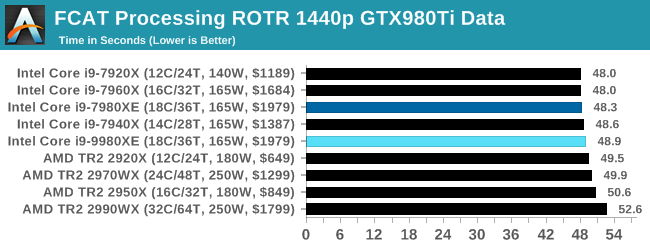
Despite the 9980XE having a higher frequency than the 7980XE, they both fall in the same region as all these HEDT processors seems to be trending towards 48 seconds. For context, the 5.0 GHz Core i9-9900K scores 44.7 seconds, another 8% or so faster.
3D Particle Movement v2.1: Brownian Motion
Our 3DPM test is a custom built benchmark designed to simulate six different particle movement algorithms of points in a 3D space. The algorithms were developed as part of my PhD., and while ultimately perform best on a GPU, provide a good idea on how instruction streams are interpreted by different microarchitectures.
A key part of the algorithms is the random number generation – we use relatively fast generation which ends up implementing dependency chains in the code. The upgrade over the naïve first version of this code solved for false sharing in the caches, a major bottleneck. We are also looking at AVX2 and AVX512 versions of this benchmark for future reviews.
For this test, we run a stock particle set over the six algorithms for 20 seconds apiece, with 10 second pauses, and report the total rate of particle movement, in millions of operations (movements) per second. We have a non-AVX version and an AVX version, with the latter implementing AVX512 and AVX2 where possible.
3DPM v2.1 can be downloaded from our server: 3DPMv2.1.rar (13.0 MB)
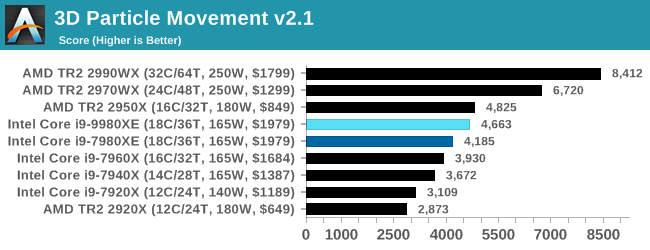
Without any AVX code, our 3DPM test shows that with fewer cores, AMD's 16-core Threadripper actually beats both of the 7980XE and 9980XE. The higher core count AMD parts blitz the field.

When we add AVX2 / AVX512, the Intel HEDT systems go above and beyond. This is the benefit of hand-tuned AVX512 code. Interestingly the 9980XE scores about the same as the 7980XE - I have a feeling that the AVX512 turbo tables for both chips are identical.
Dolphin 5.0: Console Emulation
One of the popular requested tests in our suite is to do with console emulation. Being able to pick up a game from an older system and run it as expected depends on the overhead of the emulator: it takes a significantly more powerful x86 system to be able to accurately emulate an older non-x86 console, especially if code for that console was made to abuse certain physical bugs in the hardware.
For our test, we use the popular Dolphin emulation software, and run a compute project through it to determine how close to a standard console system our processors can emulate. In this test, a Nintendo Wii would take around 1050 seconds.
The latest version of Dolphin can be downloaded from https://dolphin-emu.org/
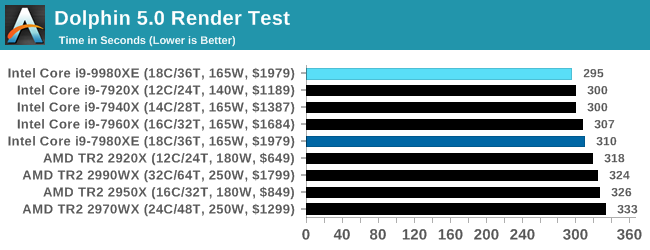
Dolphin enjoys single thread frequency, so at 4.5 GHz we see the 9980XE getting a small bump over the 7980XE.
DigiCortex 1.20: Sea Slug Brain Simulation
This benchmark was originally designed for simulation and visualization of neuron and synapse activity, as is commonly found in the brain. The software comes with a variety of benchmark modes, and we take the small benchmark which runs a 32k neuron / 1.8B synapse simulation, equivalent to a Sea Slug.
Example of a 2.1B neuron simulation
We report the results as the ability to simulate the data as a fraction of real-time, so anything above a ‘one’ is suitable for real-time work. Out of the two modes, a ‘non-firing’ mode which is DRAM heavy and a ‘firing’ mode which has CPU work, we choose the latter. Despite this, the benchmark is still affected by DRAM speed a fair amount.
DigiCortex can be downloaded from http://www.digicortex.net/
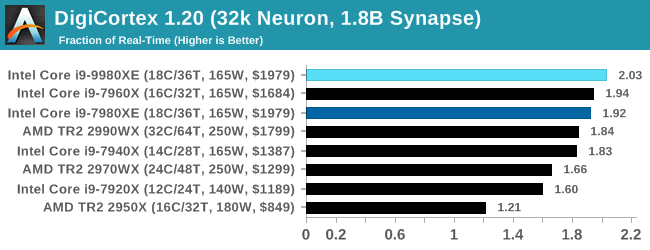
DigiCortex requires a good memory subsystem as well as cores and frequency. We get a small bump for the new 9980XE here.
y-Cruncher v0.7.6: Microarchitecture Optimized Compute
I’ve known about y-Cruncher for a while, as a tool to help compute various mathematical constants, but it wasn’t until I began talking with its developer, Alex Yee, a researcher from NWU and now software optimization developer, that I realized that he has optimized the software like crazy to get the best performance. Naturally, any simulation that can take 20+ days can benefit from a 1% performance increase! Alex started y-cruncher as a high-school project, but it is now at a state where Alex is keeping it up to date to take advantage of the latest instruction sets before they are even made available in hardware.
For our test we run y-cruncher v0.7.6 through all the different optimized variants of the binary, single threaded and multi-threaded, including the AVX-512 optimized binaries. The test is to calculate 250m digits of Pi, and we use the single threaded and multi-threaded versions of this test.
Users can download y-cruncher from Alex’s website: http://www.numberworld.org/y-cruncher/
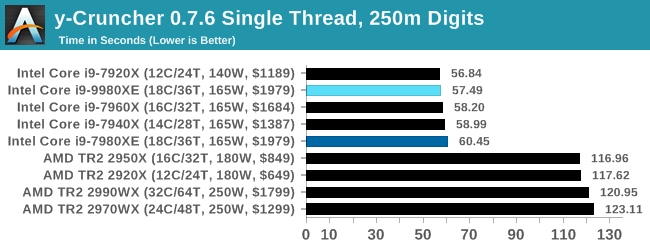
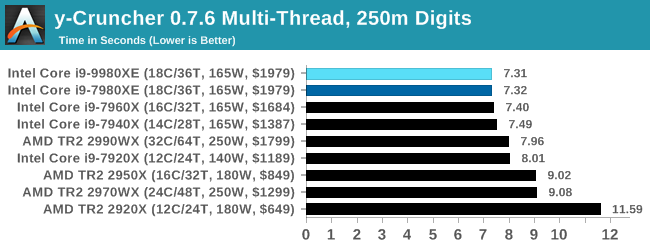
With another one of our AVX2/AVX512 tests, the Skylake-X parts win in both single thread and multi-threads.
Agisoft Photoscan 1.3.3: 2D Image to 3D Model Conversion
One of the ISVs that we have worked with for a number of years is Agisoft, who develop software called PhotoScan that transforms a number of 2D images into a 3D model. This is an important tool in model development and archiving, and relies on a number of single threaded and multi-threaded algorithms to go from one side of the computation to the other.
In our test, we take v1.3.3 of the software with a good sized data set of 84 x 18 megapixel photos and push it through a reasonably fast variant of the algorithms, but is still more stringent than our 2017 test. We report the total time to complete the process.
Agisoft’s Photoscan website can be found here: http://www.agisoft.com/
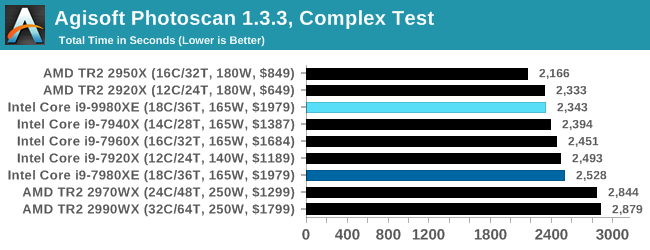
Photoscan is a mix of parallel compute and single threaded work, and the 9980XE does give another 7-8% performance over the 7980XE. The AMD dual-die TR2 parts still have the edge, however.


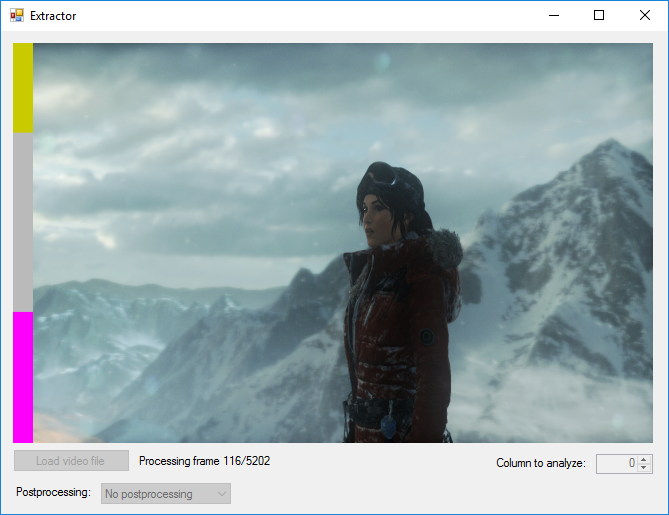










143 Comments
View All Comments
AdhesiveTeflon - Tuesday, November 13, 2018 - link
Yea, have fun waiting a month to render 2 airport terminals from a point cloud. Most professionals I know still use and have a need for desktops. If you're asking why you need this CPU then it's not for you.HStewart - Tuesday, November 13, 2018 - link
Like to see you lug a desktop though an airport.AdhesiveTeflon - Tuesday, November 13, 2018 - link
It's kind of obvious that you leave the desktop stationary for any sort of real work. My comment was how the OP rarely seen any "professionals" use desktops anymore. Engineers, CAD workers, and rendering farms still use desktops because they're still the only thing that has any grunt behind it.So while a laptop is still trying to render the airport's bathroom from the point cloud, the desktop has already done the rest of the airport and the next two point-cloud scanning projects.
HStewart - Tuesday, November 13, 2018 - link
Yes I understand that but most of one you find on forums like this are not actually professionals - but instead hard core gamers - which desktop still have a lot of that market.The ideal platform is mobile platform that connect to desktop style monitors at work and if needed at home. My work required two video ports on Laptop.
Lord of the Bored - Wednesday, November 14, 2018 - link
The ideal platform... depends on the task at hand. Crazy, I know. Some people need a small and light device, some need one they can hook multiple displays too, some need the one with the most raw power available...twtech - Thursday, November 15, 2018 - link
That's fine if you don't need the power of a desktop. Your laptop in that case is essentially serving as a SFF desktop - and if that's good enough, great. You get all the benefits of a desktop, and all the portability advantages of a laptop in a single package.I can see how that works for some forms of software development. For me personally, at work I can use all the CPU power I can get. Around 32 cores @ 5GHz would be perfect.
PeachNCream - Wednesday, November 14, 2018 - link
Render farms do not typically consist of desktop computers. The workloads you're discussing should indeed be processed elsewhere on something other than whatever machine is local to the user's desk and that elsewhere is typically not a collection of desktop-class PC hardware.M O B - Friday, November 16, 2018 - link
PNC--you made a good point earlier about thin clients and servers, but not everyone is corporate. Efficiency is moot if you can't afford to get your foot in the door.I don't expect someone who isn't in the industry to know this, but small businesses and independent contractors do the majority of the transcoding, grading, editing, and effects that make it into every single thing you watch on TV or stream. These people often use powerful 1P desktops, and occasionally a single 2P system. Obviously large effects studios don't rely on 1P, but again, most people in this industry are not employed by one of the few giants.
It's clear that you don't have these needs, but to pretend that this entire marketing segment is for "gaming," "not necessary," or inefficient is gross oversimplification. Thin clients and servers are a great solution for certain operations of scale, while for others it is as tone deaf and ignorant as crying "let them eat cake."
These powerful 1P builds are our daily bread, and if you can get by with a laptop then that's great, but check your ignorance instead of speaking from it.
AdhesiveTeflon - Wednesday, November 14, 2018 - link
HStewart, I agree. My personal work setup is the same way with a laptop and multiple desktop monitors since I don't require the power that the Engineers and CAD workers need. Most of my users that aren't Engineers or CAD designers are the same way too.PeachNCream, we just purchased a dedicated i9 for the workloads for our point-cloud rendering, but each individual engineer/cad worker still requires a beefy computer. Moving one point of our services to a dedicated computer does not stop the daily work on other projects.
MisterAnon - Wednesday, November 14, 2018 - link
You are not a professional then (and if you are a professional they made a bad hire), because unless your job requires to walk around while typing a laptop is absolutely useless for the professional world. A desktop will get work done significantly faster with no drawbacks. You're sitting in a chair all day, not out camping.